Mobile phone users spend an average of 4.5 hours on their phones every day –– not including voice calls. And about half of those users have iPhones.
It’s an unprecedented level of engagement for Apple. I mean, heck, we barely spend 4.5 attentive hours with our loved ones on a typical day –– and we’re often still on our phones during that time.
That kind of deep engagement can feel out of reach for resource-strapped growing businesses who are all clamoring for some fraction of consumers’ dwindling attention spans.
But there’s a proven framework that will help you go beyond basic customer satisfaction and architect the same type of can’t-get-enough-of-it engagement you likely have with Apple products, your closest friends, Amazon’s delivery service, and your latest Netflix binge.
And spoiler alert: It’s not about designing an elaborate loyalty or referral program.
Let me introduce you to the head-hands-heart engagement framework, a holistic approach to engagement that paves the way for customers to form and sustain a genuine bond with your business.
As an engagement consultant who’s worked with both large organizations like the United Nations and the Church of England and small local businesses, I’ve seen the application of this framework pay off time and time again. Along the way, I’ve developed a deep understanding of why this model helps connect people to brands, beliefs, and one another.
In this article, I’ll peel back the curtain on the head-hands-heart framework, and show you how to use it to engage your customers in ways that are deeply meaningful to you and them.
It consists of cognitive engagement (head), behavioral engagement (hands), and affective engagement (heart), leading customers from awareness to action and then to a deep, integrated bond.
Practical application includes honing a clear and authentic message, choosing the right channels, crafting engaging events, forging connections, highlighting benefits, and fostering customer development.
OpenPhone supports this engagement strategy with features like multiple touchpoints, personalized reminders, and integration with customer relationship management systems.
Remind me: what is customer engagement?
At its core, engagement is a state of togetherness; it’s an exercise in relationship-building. And so, customer engagement is the act of building relationships between a business and its customers.
This concept encompasses all the ways in which users interact with a brand or business offering –– in real life and online.
Deep customer engagement ultimately leads to a more profitable business: Consumers who are genuinely engaged with a company make purchases from them 90% more frequently, spend 60% more with each transaction, and are five times more likely to be loyal to that company.
The head-hands-heart engagement framework, explained
True engagement has multiple layers. It simply can’t be built or nurtured with a surface-level approach.
The head-hands-heart framework honors this fact by acknowledging the three core states of engagement:
- Head engagement: This is cognitive engagement. Ask yourself what your customers or prospects know about your business? Are they mentally connected to your business?
- Hands engagement: This is behavioral engagement. Ask yourself what your customers do with your product or service? Have they taken action and become physically connected to your business?
- Heart engagement: This is affective engagement. Ask yourself what your customers become as a result of using your product or service? How have they become integrated with and bonded to your business?
A customer who has reached heart engagement will have first come to know your brand or business (head engagement), then taken action to become involved with your product or service (hands engagement), before developing a deeper bond with your company (heart engagement).
In other words, head, hands, and heart are the three building blocks that form capital-E engagement. Let’s do a deeper dive on each one.
Head engagement
Being genuinely engaged with any business begins with acquiring core knowledge. First and foremost, a potential customer needs to know you exist –– they need to understand who you are and what you do.
If you’re struggling to get customers, you’re likely falling short in this category.
This is where you have to take a good, hard look at how clearly you’re communicating with your audience: What, if anything, do they know about your business? Do they know your name? Why you’re in business? Your business offerings?
If someone has acknowledged your existence, understands your raison d’être, and wants to learn more, they’re cognitively engaged with you.
In this state of head engagement, a consumer hasn’t actually used your products or services yet. But they’ll be self-motivated to start exploring what you have to offer –– to begin the inevitable fact-finding mission humans jump into when something genuinely piques their interest.
Hands engagement
If head engagement exists in earnest, a consumer will move to hands engagement. That is, taking action and engaging with your business on a behavioral level.
This is where a consumer becomes a customer as they begin to try your products and services. But hands engagement isn’t at its best until a customer forms a relationship with your product or service.
If someone is an occasional user of a particular app on their phone, that doesn’t automatically mean they relate to that app or what it offers.
Hands engagement represents when a user’s behavior goes beyond initiation and becomes ritual.
For example, a person who periodically goes to the gym takes some level of action, but someone who’s in the weight room six times a week and identifies themself as a gym-goer has a relationship with the gym.
Heart engagement
Once a customer is engaged in head and hands, they might progress to heart engagement. This is where a person feels completely bonded to and integrated with your business.
Heart engagement is a next-level state of engagement that’s absorbed into your being and becomes part of your identity. It isn’t about what people feel; it’s deeper than emotion. It’s what people become because of the bonds they’ve formed with something.
Take the person who strength trains at the gym six times a week. They’re highly invested in what the gym offers, so they strive to help others at the gym and might become a personal trainer.
That person has integrated the gym into their life and fully enlisted in the gym experience –– it’s part of who they are now. The gym’s success, and other people’s success at the gym, is also their own success at this point.
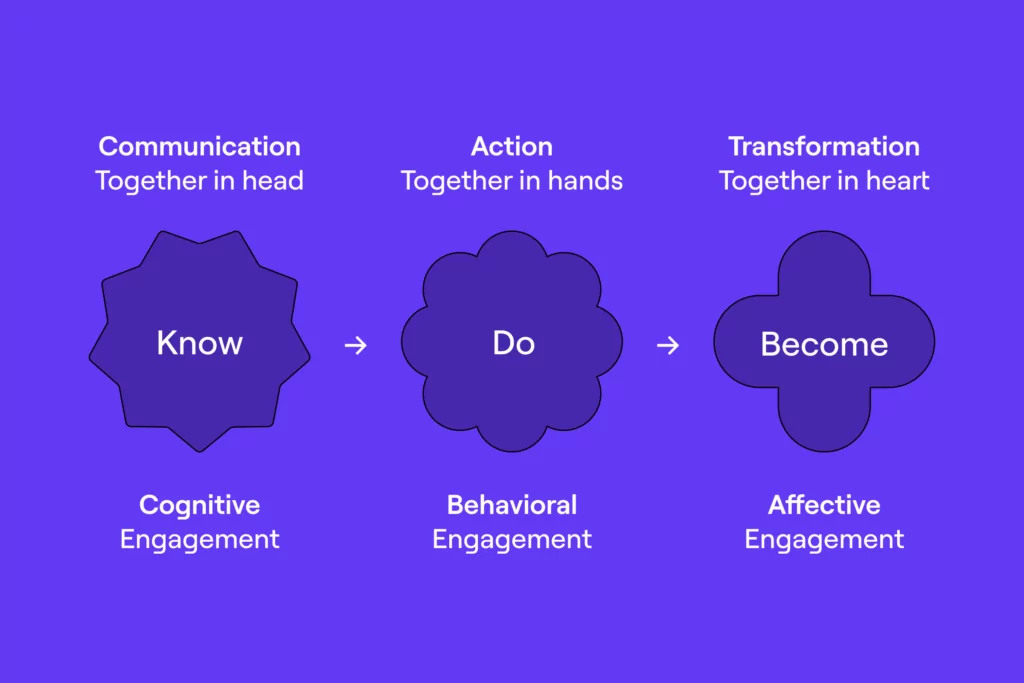
6 pieces of the customer engagement puzzle –– and how to approach them
Now that you have a handle on the head-hands-heart framework, I’ll offer some practical ways to apply elements of that framework.
Careful consideration of these six key segments will help you design a customer engagement strategy that organically guides your customers toward heart engagement territory.
Piece #1: Your message
A customer simply can’t even begin to develop a relationship with a business if they don’t understand what the business is all about.
Engagement begins and ends with your core message to customers. Your positioning statement needs to be memorable enough that someone can easily relay it to a friend.
Consider any product you know and love. You can easily describe their essence and why they exist, right?
For example, Snickers is a candy bar with peanuts and chocolate. I’d consider eating it if I’m hungry or need energy. But if I’m looking for a more luxurious chocolate treat, I’d probably pick Cadbury Dairy Milk.
To implement this part of the framework and develop a message that resonates:
- Talk to your target customers: Practice active listening. Find out why they value – or don’t value – your product or service. Discover what type of messaging sticks with them and which benefits they find indispensable.
- Lean into clarity and simplicity: Simple, clear messages are more memorable than ideas that are shrouded in flowery, indirect language. Beyond that simple writing tends to produce better business results. Focus on concrete terms, outcomes, and analogies to quickly convey meaning.
- Maintain authenticity: Stay true to your company’s vibe. If you’re the embodiment of fun and playfulness, inject those qualities into your message.
- Get feedback: And use that feedback to refine your message. Getting it right on the first try is rare. Solicit feedback from existing customers and prospects, then fine tune and test options based on what you learn.
Piece #2: Channels
“If a tree falls in the forest and no one is around to hear it, does it make a sound?”
In other words, you might have crafted the stickiest, most memorable message in the world, but if it doesn’t reach your audience, what’s the point?
When it comes to head engagement, another consideration has to be your distribution channels: where, when, and how you communicate messaging to your customers and prospects.
There are a million digital and physical places to engage your customers in 2023 –– from email to SMS to social media to events to books. It’s up to you to determine the right channels for the messages you’re delivering and the audience you’re trying to reach.
To implement this part of the framework and ensure your message reaches your customers:
- Offer multiple touchpoints: Your customers typically need to see your brand at least seven times before they remember it. Figure out how to make your message accessible to your customers across a range of online and offline channels. Regular points of connection also offer opportunities to establish a learning relationship between you and your customers.
- Make sure the message fits the channel: An HTML email message with lots of design elements simply won’t fit into a 160-character SMS message. Similarly, a 2,500-word article on your blog will need to be translated into shorter formats for your social media channels.
- Understand algorithms: But don’t feel the need to kneel before them. Wrap your head around how algorithms work across different digital channels so you can look critically at your channel landscape and distribute your message in ways that will actually reach your audience.
Piece #3: The event
If your message is memorable and resonates with your audience across one or more channels, they’ll feel compelled to take action –– to start using your product or service. And so, they’ll officially enter the realm of hands engagement.
This event –– or initial involvement with your product or service –– comprises a series of actions that all connect back to a customer’s first hands-on experience of your business offering and, ultimately, work together to determine how engaged that customer is at this stage.
For example, a new bookstore customer will visit the shop for the first time (the primary event). While there, they’ll participate in many micro-actions: They’ll digest the atmosphere of the bookstore, peruse the books on the shelves, maybe ask a staff member to help them find a specific book, and potentially purchase said book.
Before you can begin designing a highly engaging event, you have to guide prospects toward that event.
To implement this part of the framework and convince head-engaged potential customers to take action:
- Make it easy to get involved: Don’t make people jump through hoops to try your product or service. Offer simple paths –– complete with clear language –– to trials and first experiences. A frictionless customer experience is much more engaging than a high-effort one.
- Send strategically timed event reminders: Even if a prospect is ready to try your product or service, life can get in the way. A last-minute shift in priorities, a canceled appointment, a no-show –– they’re all just part of the deal these days. But you’re more likely to see participation if you set up automatic event reminders. Time reminders to send right when the appointment is booked, one day before the appointment is scheduled to happen, and one hour before the event.
OpenPhone Team Tip: Boost customer participation with automatic reminders
OpenPhone customers have the benefit of being able to easily craft and schedule messages directly in the platform.
Tap into OpenPhone’s Zapier integration to automatically receive a confirmation text with each event booking that comes through an appointment scheduling app like Calendly.
Then, tee up your predetermined sequence of appointment reminders and updates –– via the Zapier integration, or right in OpenPhone –– so they deploy when you want them to.
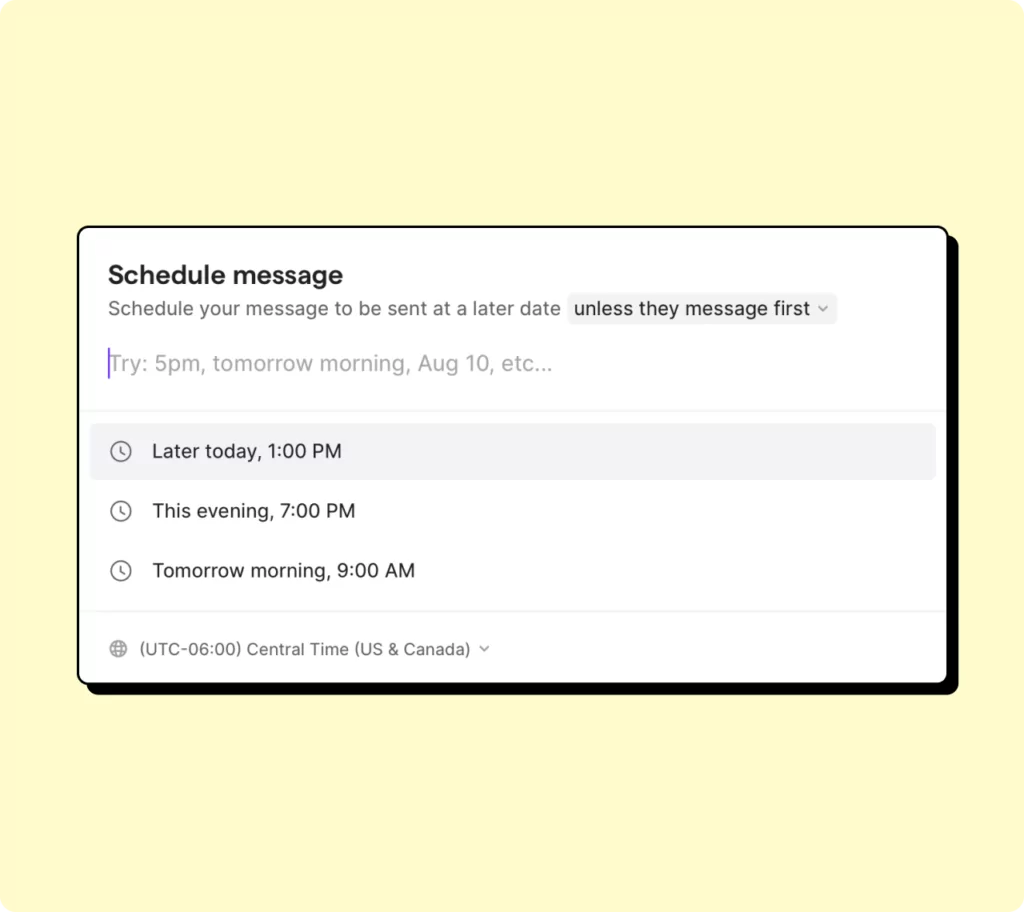
Piece #4: The connection
Once you get customers through your digital or brick-and-mortar door, they’ll naturally determine how they connect – or, don’t connect – with the experience you offer.
Not every customer will forge a strong relationship with your product or service. Some might walk away and never engage with your business again.
But if a customer relates during the event, it’s the first step on the road toward heart engagement.
Picture your favorite lunch spot. Sure, its menu is probably full of the same sandwiches and salads as all the other cafés in the area, but you keep going back anyway. Why? Because you’ve built a connection with that specific place.
To implement this part of the framework and help customers seamlessly form a connection with your business:
- Cast a critical eye on every part of the experience you offer: Figure out how you can make every aspect of your customer experience as low-effort and high-quality as possible. Continually examine and audit the many pieces of that experience to determine how you can improve or build on them. For example, if your business is a real estate firm, analyze the customer’s appointment booking process, their interactions with your agents, and their experience visiting properties. Where can you dial up points of connection?
- Identify your special sauce and bottle it up: Offer something unexpected. Learn your customers’ expectations, then break them. Surprise people throughout their experience. When DoubleTree started offering chocolate chip cookies at check-in in the 1980s, you better believe those customers felt a stronger sense of connection to that hotel group.
- Help customers form their own connections: If your customers can build new social connections at your event, they’ll value your business even more. Create opportunities for customers to connect with other customers at your events.
OpenPhone Team Tip: Improve your customers’ experience with contact notes
Building deep relationships with your customers is much easier when you remember meaningful details about their lives.
Keep track of all their interests, upcoming plans, and important milestones by taking notes right in your phonebook.
OpenPhone customers can record client notes in the app and quickly pull up information about a specific client when needed –– or transfer the entire client relationship to another team member at any point.
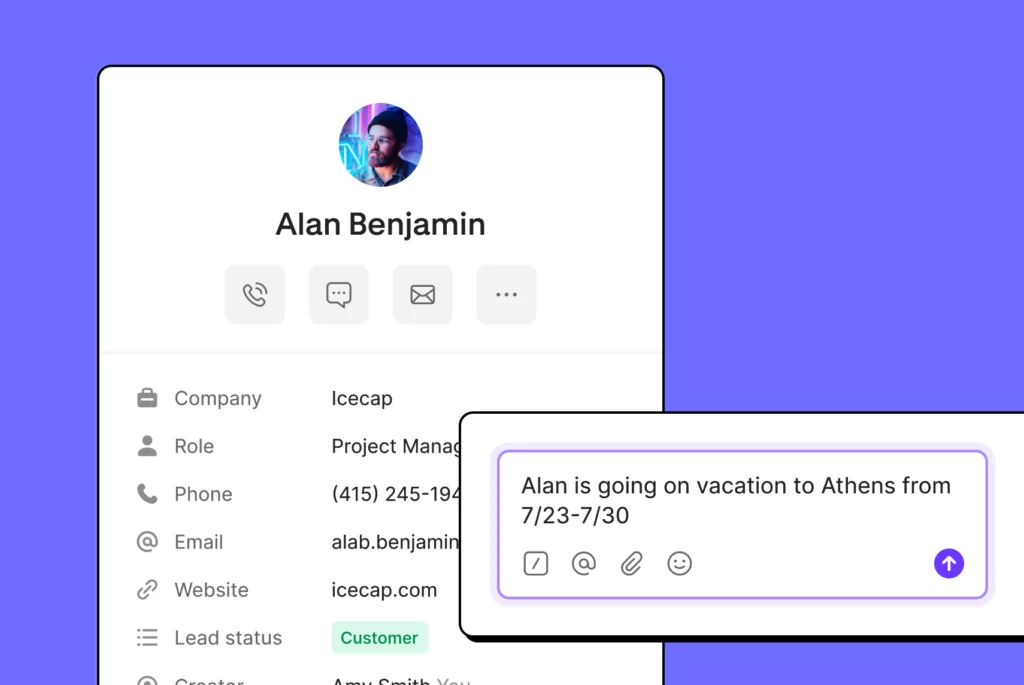
Piece #5: Benefits
When a customer sees how they’ve benefited from using a product or service, those realized benefits unlock a deeper sense of engagement.
Doing a test run is one thing, but actually benefiting from a product yields a sense of trust with customers –– a feeling that the business will actually deliver on their promises.
If you use a fitness app, but you don’t hit your fitness goals by using that app as instructed, then the app hasn’t kept its promise to you. So, why would you continue to be engaged with it at that point?
To implement this part of the framework and help customers understand and experience the benefits of doing business with you:
- Close loopholes: A key part of building engagement is building integrity. When you’re helping a customer, focus on seeing things through to the end and communicating effectively along the way. Mirror their challenge back to them so they know you understand it, describe what you’re going to do to help them, tell them when you’re doing it, and then –– when you’ve finished –– tell them it’s done. Confirming that you’re “on it” is a powerful thing. Plus, connecting at each of these milestones offers multiple moments of engagement and reminds customers of the value your business delivers.
- Ask politely for testimonials and reviews: Giving a testimonial or review provides customers with the opportunity to reflect on their experience with your product or service –– they’re reminded of the benefits they receive from it. Ask politely for these items, and try to ask in person to underscore how much you value this customer relationship and how meaningful reviews are to your business.
“A key part of building engagement is building integrity. When you’re helping a customer, focus on seeing things through to the end and communicating effectively along the way.”
Piece #6: Development
When customers use your solution continually, fully grasp its benefits, and clearly see how it improves their lives, they enter the development phase of engagement. They see the long-term relationship they intend to have with your business; there’s an opportunity for them to develop further as a result of your offering.
Take LEGO, for example. Each LEGO brick not only adds value to what a customer is building, it also represents the potential for them to build more.
To implement this part of the framework and foster an environment where your offering become fully integrated into your customers’ lives:
- Delight customers with added utility: Consider what else you can do for customers that would increase your business’ value to them –– and, in turn, their value to you. Instead of asking, “What else can I do for you today?” try something more akin to, “Here’s what else I can do for you.” Business consultant Alan Weiss famously said one piece of business is always three pieces of business: the original business, the repeat business, and the referral. A contractor who runs a roofing business can turn a single maintenance job into a long-term relationship if they keep an eye out for other fixes that would improve the customer’s safety and quality of life.
- Remember your humanity: At the end of the day, engagement is about human relationships. Customers connect with the people behind a business, not the faceless brand. You might be acting on behalf of a business, but don’t forget your humanity.
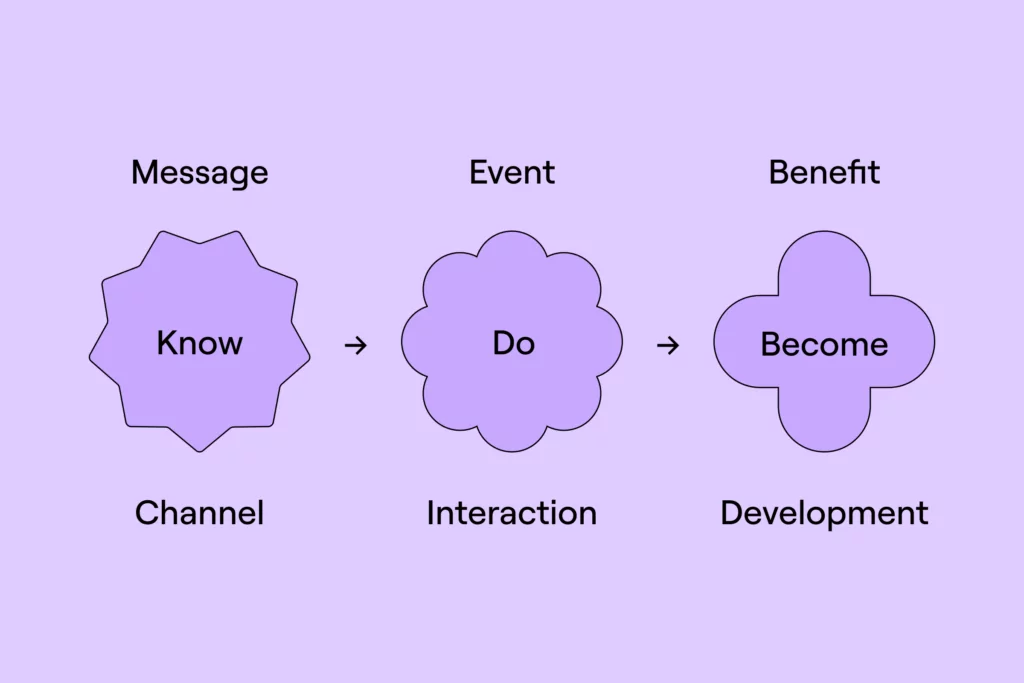
Easily engage your customers –– in head, hands, and heart –– with OpenPhone
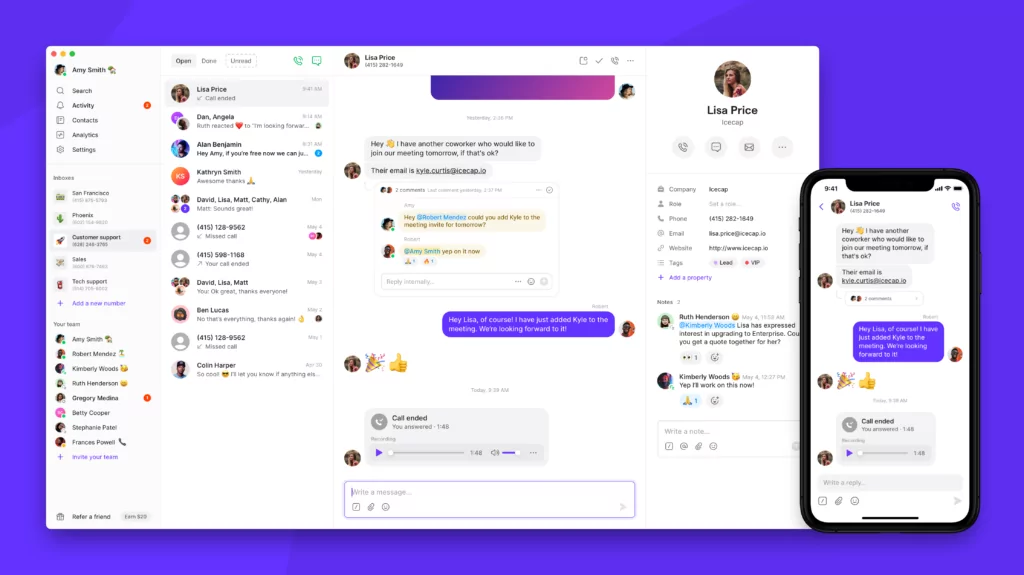
When it comes to driving genuine engagement with your customers, being aware of the different states of engagement –– and how you can create universal engagement by finessing various aspects of the head-hands-heart framework –– is half the battle.
But putting that knowledge into practice can get complicated if you don’t have the right tools in place.
Fortunately, communication platforms like OpenPhone make it easy to keep pace with today’s customers and build meaningful, symbiotic relationships with them at every turn.
From custom properties to contact notes, integrations with customer relationship management systems like Salesforce and HubSpot, and features like auto-replies, OpenPhone offers a world of shortcuts that make customer engagement less of a lift. Sign up for a free seven-day trial today.

